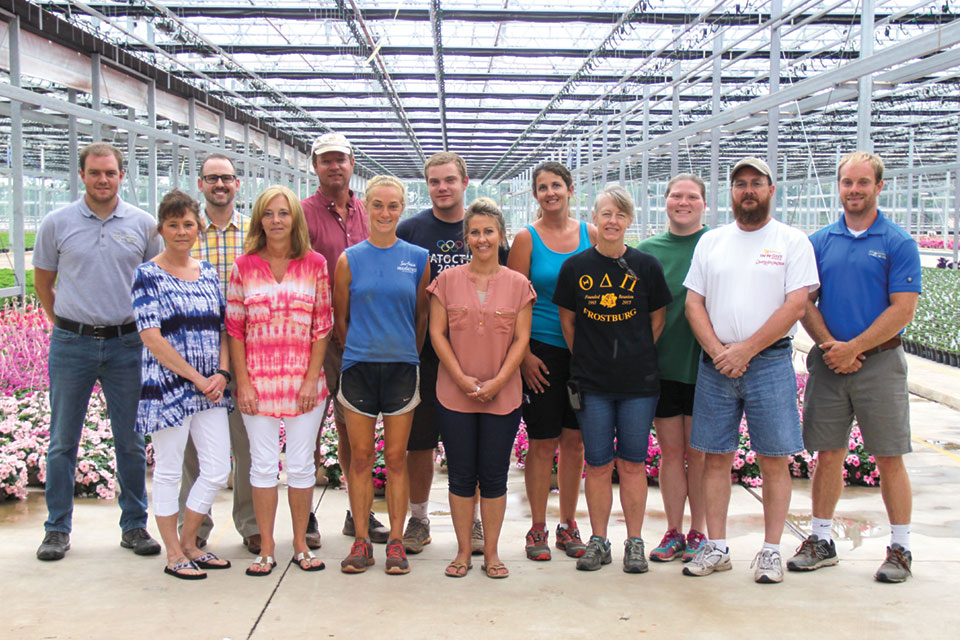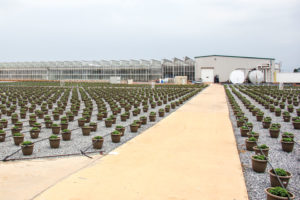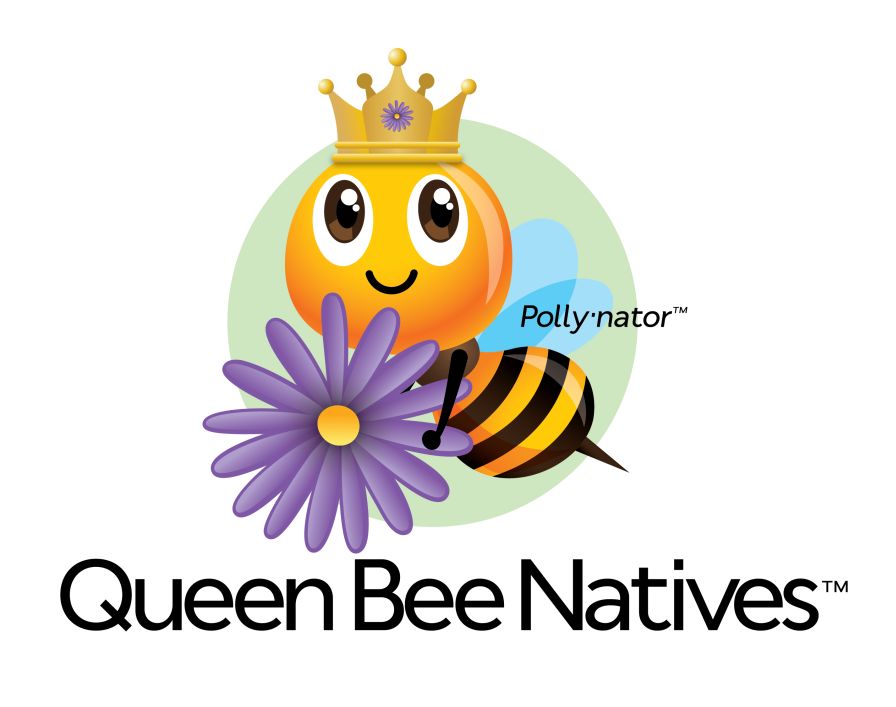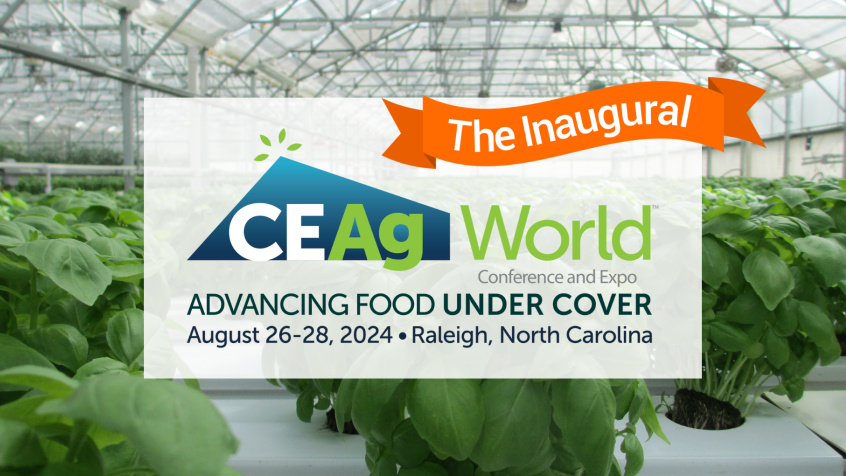Innovation Never Stops at Catoctin Mountain Growers

Staying on top of new innovations is a team effort at Catoctin Mountain Growers, and communication is a big part of that process. Photo credit: Patricia Grim
Bob and Denise Van Wingerden started Catoctin Mountain Growers in Keymar, MD, in 1985 with just 1 acre of greenhouse space. The company is still family owned and operated 32 years later, but has since expanded to 15 acres under glass, as well as 10 acres of outdoor growing space.
In keeping with the legacy of the Van Wingerden family, Bob and his son, Tyler, who is currently head of sales at Catoctin Mountain Growers, are constantly looking to grow, not just in size but also in innovation. The company is always looking for ways to improve its production practices and gain efficiencies in areas from communications to shipping.
Here’s a look at some of the recent technological advancements the company has made, as well as what’s on the horizon.
Slow Sand Filter Helps Reclaim Water
The idea of adding a slow sand filter at Catoctin had been in the works for a while, and was solidified when Bob and his brother spent some time in Haiti working with fish and water filtration.
“The slow sand filter was built for using pond water, which is reclaimed rain water, to irrigate our entire facility,” Bob Van Wingerden says. “We have one sand filter unit in place that was designed to filter up to 100 gallons per minute.”

Catoctin’s slow sand filter works as both a particulate filter and a biological filter. As the water passes through, the sand kills the pathogens without stripping everything out of the water.
Adjacent to the filter is a 500,000-gallon holding tank where fresh water is stored. This allows the sand filter to run 24 hours a day, which is necessary for the bacteria living in the sand.
“The slow sand filter works as both a particulate filter and a biological filter,” Bob says. “As the water passes through, the sand kills the pathogens without stripping everything out of the water. You’re left with water that is filled with good bacteria.”
Currently, Catoctin uses a mix of filtered pond water and well water.
“Our goal is to use 100% pond water,” Bob says “There is still a lot of learning to be done with the slow sand system, and we are developing procedures for cleaning and re-using the sand as it gets dirty.”
Improved Shipping Efficiency
Catoctin is also in the process of building a new shipping facility that will enable the operation to remain efficient in loading orders. The new facility will be built with custom dimensions that fit with Catoctin’s cart size and trailer arrangements.
“This is not something that we have come up with, but we have seen it at other successful greenhouses such as Color Point and Metrolina,” says Tyler Van Wingerden. “We will stage the carts on the floor as they would sit in the trailer.”
The shipping area will be about 80,000 square feet with the capacity of moving close to 3,000 carts a day, setting up the company for efficient logistics for years to come.

When completed, Catoctin’s revamped shipping area will be about 80,000 square feet with the capacity of moving close to 3,000 carts a day, setting the company up for efficient logistics for years to come.
Tyler also points out that Catoctin is building outdoor space now that will be set up to accommodate a fork lift and wagon system. The bays will be 500 feet long and 60 feet wide.
“There will be a boom that covers each section,” Tyler says. “The boom will have a belt on it to help move product out of the bays. We will have a forklift that spaces the plants from production onto the bay. The plants will come from the production barn on a wagon sized for the forklift. After proving this concept on the outdoor space, we will use the forklift and wagon system in our greenhouses.”
Moving From HPS to LED
Like many growers, the Van Wingerdens are always looking for ways to improve lighting systems at Catoctin. The company currently uses high-pressure sodium (HPS) lighting, but is looking for a system that is less prone to maintenance needs.
“HPS starts out nice but tends to degrade quickly,” Bob says.
Catoctin is currently working with Fluence Bioengineering to set up LED grow lights in one of its greenhouses.
“We’re in the initial phase of that project, but have not committed to any fixtures,” Bob says. “We are still waiting to see if it is cost effective.”
Enhanced Communication
Two years ago, Catoctin set up wireless internet across the entire facility.
“Our initial motivation was to find a cheaper and more productive way to communicate through the greenhouse,” Tyler says. “We use a phone app that operates like a walkie-talkie. The app allows for pictures and direct conversations as well.”
Managers at Catoctin now have a section of Echo devices connected to an internal network, and the growers can monitor the status of the Echoes from their smart phones — the same ones they use to communicate with the team. Managers and lead growers have e-mail on their phones and can stay up to date, even when they’re away from the office.
“We plan to bring more pieces online, as we adapt the ‘Internet-of-things’ mentality in the greenhouse,” Tyler says.
Inventory management can be a problem for any grower, and Catoctin is attempting to streamline its inventory information gathering using a program from SBI.
“We are not ahead of the curve on this, but it will be a great improvement to our old system,” Tyler says. “All our managers have smart phones, and SBI’s inventory system is a web-based program that will allow
our team to update and grade inventory from anywhere in the greenhouse.”
How to Prioritize
When you add up all of the upgrades taking place at Catoctin Mountain Growers (and that’s not even including future projects), it equates to a lot of time and resources allotted to the innovation process. So how do the Van Wingerdens determine where to invest?
“We want to invest in the areas that we see as our biggest opportunities for improvement,” Tyler says.
Water filtration was one of these areas.
“We were not happy with the systems we had tried, and we believe the slow sand filter will be a good answer to that problem,” Tyler says.
Perhaps the biggest factor that Catoctin uses to determine where to invest is labor efficiency.
“Like all growers, we struggle with labor, and the seasonality and difficult work load make hiring a challenge,” Bob says. “We will continually look to automate the processes that are the most labor intensive, such as transplanting, production, and spacing.”
It can also be difficult to keep up with the potential opportunities in technological innovation that may be on the horizon.
“We make sure we go to all the big trade shows like Cultivate, as well as international shows in Holland,” Bob says. “It’s always interesting to see what growers are doing there.”
Being part of a big growing family with a long legacy in the industry also helps.
“We are constantly talking to our family of growers,” Bob says. “They are trying to innovate the same way we are, and there is always something we can learn from each other.”










